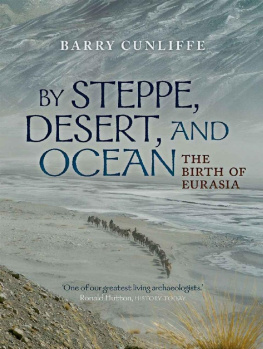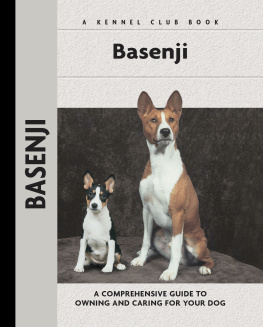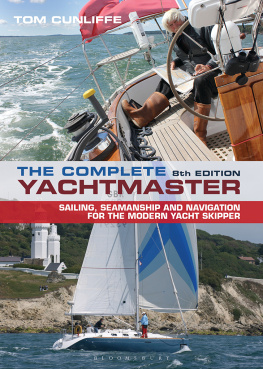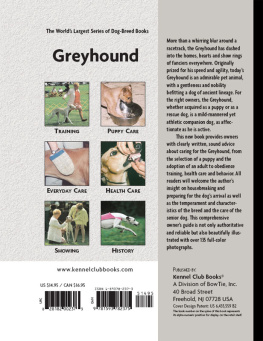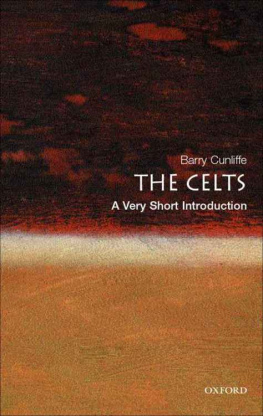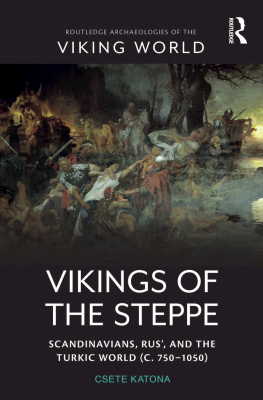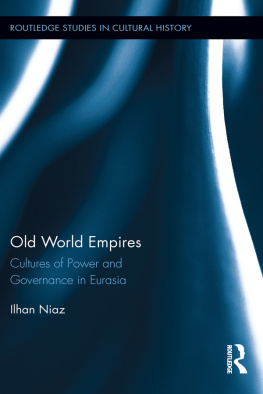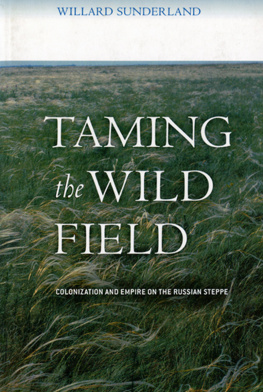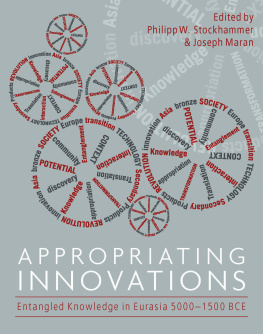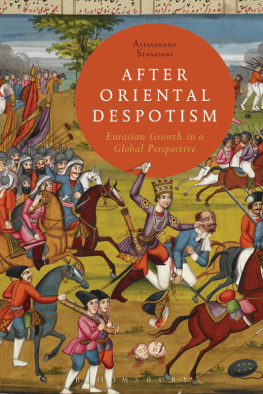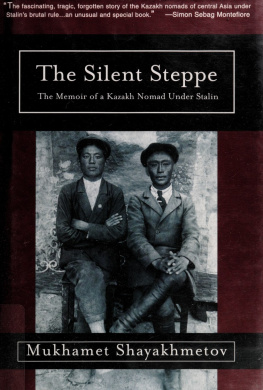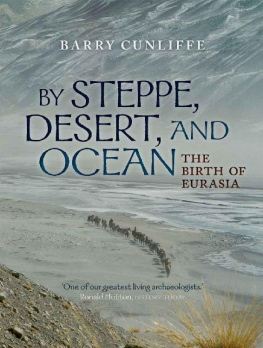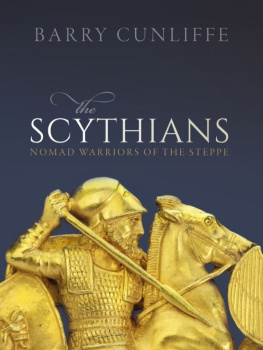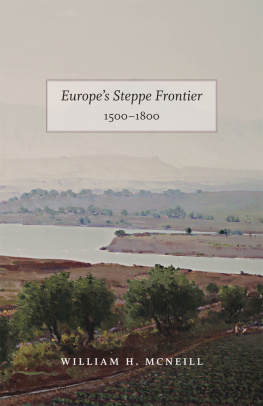By Steppe, Desert, and Ocean
The Birth of Eurasia

Barry Cunliffe


Great Clarendon Street, Oxford ox2 6dp , United Kingdom
Oxford University Press is a department of the University of Oxford. It furthers the Universitys objective of excellence in research, scholarship, and education by publishing worldwide. Oxford is a registered trade mark of Oxford University Press in the UK and in certain other countries
Barry Cunliffe 2015
The moral rights of the author have been asserted
First Edition published in 2015
Impression: 1
All rights reserved. No part of this publication may be reproduced, stored in a retrieval system, or transmitted, in any form or by any means, without the prior permission in writing of Oxford University Press, or as expressly permitted by law, by licence or under terms agreed with the appropriate reprographics rights organization. Enquiries concerning reproduction outside the scope of the above should be sent to the Rights Department, Oxford University Press, at the address above
You must not circulate this work in any other form and you must impose this same condition on any acquirer
Published in the United States of America by Oxford University Press 198 Madison Avenue, New York, NY 10016, United States of America
British Library Cataloguing in Publication Data
Data available
Library of Congress Control Number: 2014948240
ISBN 9780199689170
ebook ISBN 9780191003363
Typeset by Sparkswww.sparkspublishing.com Printed in Great Britain by Bell & Bain Ltd., Glasgow
For Maggie and Stewart who taught me about horses
Preface
Many years ago I was expounding at length on some topic to my young son, who sat patiently for a while and then said, Yes, dad, but how does it connect? That one question has been with me ever since. Whatever may capture our imaginationthe beauty of a Song bowl, the behaviour of wild horses on the steppe coming down to drink in the evening, the statue of the mathematician al-Khwarizmi in Khiva, or the name of a Viking scratched in runic script on a balustrade in the Hagia Sophiaput them in context, embedded in a web of connectivity, and they become infinitely more fascinating and take on entirely new meanings. History is far more than a series of events and the biographies of big names; it is the subtle interweaving of human actions spread over vast landscapes and through deep time creating a dense fabric, every thread of which has significance. The wonder of it all lies in how interconnected everything is.
This book is an attempt to explore the two big themes, connectivity and mobility, as they developed throughout Eurasia from early prehistory, binding the world into a single system by the fourteenth century ad . It is the story of the energizing relationship between sedentary states, like China, the Near East, and, later, Europe, with the pastoral nomads of the steppe, whose huge homeland spread from Mongolia to Hungary, and with the maritime communities living around the ocean fringes. The steppe, the deserts, and the oceans created the connective tissue through which people, commodities, and ideas flowed.
To cover the whole of Eurasia throughout its formative first ten thousand years is something of a challenge. I am fully aware that every paragraph in this book could easily be expanded to a chapter. The task has been to be rigorously selective, to focus on the dynamics that seem important to the understanding of the narrative rather than to be lured into attractive sidelines. Thus, the impact of climate change is a recurring theme, while Alexander the Greats adventures in Asia are given only brief mentiontoo brief, I suspect, for some. All I can plead is that selection is a personal matter. I learnt about it early in life. As a very young archaeologist in the 1960s I had to give a lecture on one of my excavations to an august audience in Oxford. It was an unnerving experience. Afterwards my mentor, the doyen of Roman studies Sir Ian Richmond, came up to me. Sensing my discomfort, he put his hand on my shoulder and said, That was good (pause) it wasnt so much what you put in as what you left out. I can only hope that this time I have also got the balance about right.
The narrative relies heavily on archaeological evidence, much of which has only become available since 1990, and upon historical sources. I have used DNA evidence sparingly, not because there is any doubt about its usefulness, but because there is still much to learn about how to use it. Only when much more genetic data has become available and we have come to appreciate its nuances will it become a major contributor to the debate. More surprising to some readers will be the absence of any reference to speculations about language. This omission is deliberate since I want the archaeological and historical sources to stand on their own and not be constrained by circular arguments dominated by linguistic theories as has so often happened. When the archaeological evidence has had time to demonstrate its strengths, then the debate can begin afresh.
I have always been interested in landscape, but writing this book has made me even more aware of the crucial impact of geography on human perception and behaviour. This is one of the reasons why so many maps are included to help us visualize the environments and spaces with which people had to engage. The maps and photographs are an aid, but nothing can replace the experience of being there. I have had many memorable experiences researching this book: crossing the Taklamakan desert in a sandstorm, arriving at Palmyra on the edge of the Syrian desert bowed by the intense loneliness of the place, looking east to the endless sand across which the camel trains brought exotic goods to satiate the Roman desire for luxuries, or riding on a summer afternoon across the Mongolian steppe, the horse scuffing up the heady smell of the herbs, aware only of the peace, calm, and oneness of it all. To be there is to understand. I can only hope that this book will encourage at least some of its readers to explore a few of the places mentioned, the better to appreciate the people whose lives these landscapes have shaped.
Barry Cunliffe
Oxford
October 2014
Contents

This is the story of people and the landscapes in which they livedthe actors and the stagea story created largely without the benefit of a script and pieced together from fragments of disparate evidence brought to light by a formidable range of specialists. It is a narrative set in Eurasia covering some ten thousand years of human endeavour.
If we begin with the proposition that history is the result of human action constrained and empowered by environment, then it follows that we need to understand something of the human animal and the imperatives hard-wired into the beasts genetics, and we need to comprehend the landscape in all its ever-changing variety.
All living matter is governed by two desires: to feed itself and to reproduce its species. Humans share these desires but are more complex beings, differing from all other species in their intense acquisitiveness. This innate desire to acquire manifests itself in two forms: the passion to take ownership of commodities and the need to gather knowledge and informationto know. It is this inquisitiveness that has, over the millennia, drawn humans to explore every ecological niche on earth and to occupy most of them. It is, arguably, the one instinct that separates us from the rest of the animal kingdom.

